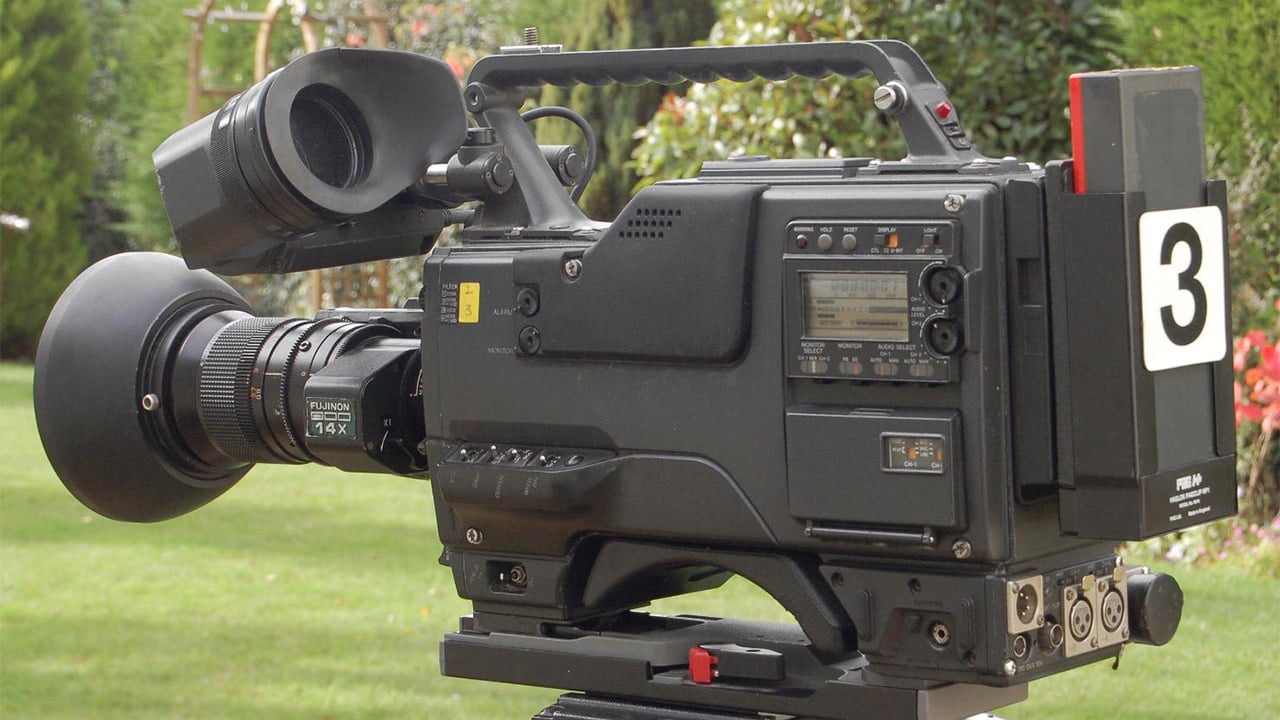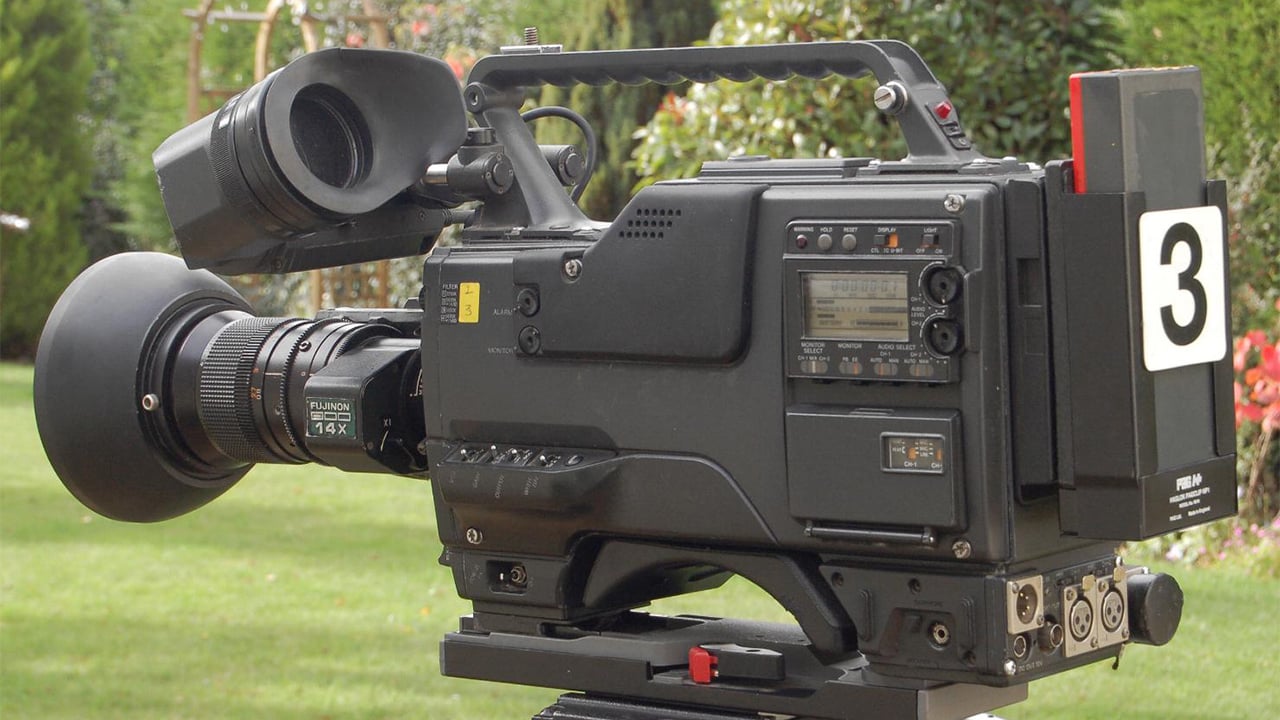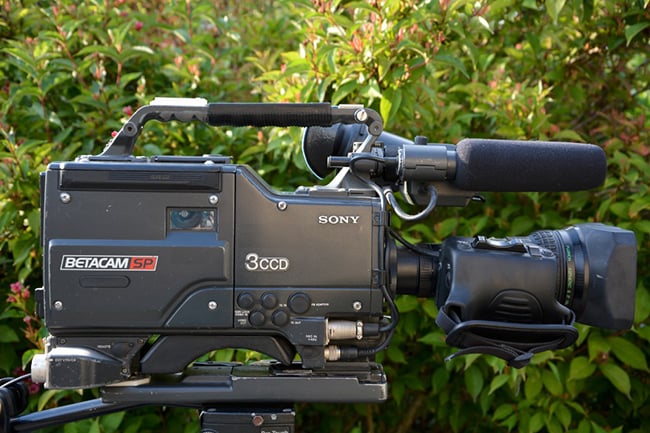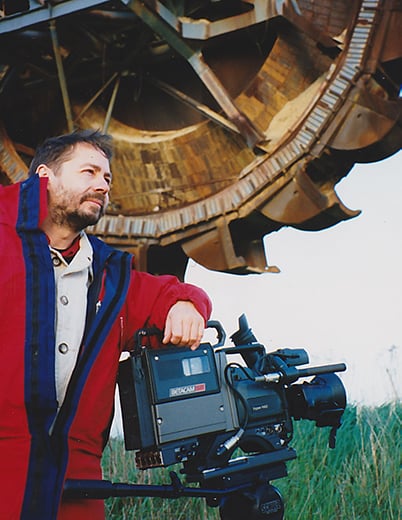
Until the 1980's film ruled the roost for location television work, until Sony developed its soon to be ubiquitous Betacam format. Then everything changed.

Our survey of camera evolution has, so far, been exclusively concerned with film cameras. Television had been an increasingly important force in the second half of the 20th century but there were still clear delineations between the worlds of photomechanical film and electronic TV – not only in technology, but in working practices.
Until the 1980s, broadcast video cameras were restricted to multi-camera TV studios, where editing was done largely in real time by switching between cameras. Portable video had arrived in the 70s with devices like the monochrome Sony Portapak, but they were far below broadcast standard and, for the time being, they would remain strictly amateur devices; news and anything requiring a portable camera would be shot on 16mm film. Older readers might remember BBC shows like the early Doctor Who, which, although largely shot in the studio with electronic cameras, would make an abrupt and disruptive switch to film for exterior locations and fight sequences.
Two different cultures
When the Portable Single Camera (PSC) or Electronic News Gathering (ENG) cameras emerged, there were conflicts as to whether this was best performed by studio people (because it was electronic) or film people (because it was single camera).
Not only were the ways of working different, but the culture of film and TV were very different. If I may indulge in some stereotypes and simplifications, TV studio people tended to be permanently employed staff, often with a solid engineering background whereas film people were often freelance. The documentary film camera person or the drama film DoP did not really have an equivalent in the TV studio where camera operator and lighting director were very different roles. A multi-camera studio, with a set lit so that it could be shot from any angle, gave little chance for the operator to be creative. Film people liked to think of themselves as creative mavericks, while TV studio people might regard them as technologically undereducated and undisciplined; rock band versus orchestra.
I believe these two very different approaches to filmmaking held back the development of video; whereas companies like Kodak would work closely with DoPs when introducing new filmstocks, Sony and other video manufacturers worked solely with engineers. The first demonstrations of HD video looked very unimpressive to film people – bright, sharp images lacking in aesthetic quality and style which did not do the medium justice. Now, of course, the tide has turned and manufacturers are only too keen to evoke elusive, subjective qualities of the ‘film-like’, ‘cinematic’, ‘organic’ and ‘characterful’.
 The first Betacam cameras had tubes. Later examples such as this were CCD based.
The first Betacam cameras had tubes. Later examples such as this were CCD based.
U-Matic and Betacam
Initially confined to news work, the first common format for broadcast PSC/ENG was Sony’s BVU – Broadcast Standard U-matic, also known as High-Band U-matic, recording on ¾” tape in cassettes. BVU arrived in the early 1980s as an upgrade to Sony’s Low-Band U-matic, first introduced in 1971 as an industrial/educational format. Up until then, broadcast video had been reel to reel, initially on 2” tape and then 1”.
Video formats up to this point had been analogue, composite systems – the colour and luminance being encoded in one single channel. All this was to change when Sony introduced Betacam in 1982. Betacam was an analogue component systems, using 3 separate channels rather than one, recording on ½” cassette tape – this was a huge leap forward in quality. The cassettes were physically identical to the ones used for domestic Betamax, a form factor that Sony would continue to use into the next century for the digital formats (DigiBeta, BetaSX, IMX, HDCam, HDCamSR) that followed. In 1986 Betacam was superseded by the upgraded Betacam SP that used metal-formulated rather than ferric oxide tape.
But this series of articles is about cameras rather than formats, so what is crucial to our story is that with Betacam, Sony moved the recorder into the camera. This established the form of shoulder-mounted broadcast video cameras for the next three decades.
The first Betacam cameras were actually made in two sections, with the recorder bolted on to the camera. You seldom saw these two parts unbolted but the ‘dockable’ recorder enabled it to partnered with an Ikegami camera head, which some regarded as a superior combination. Later cameras would be one-piece units with the recorder built-in to the camera body – as has been the case with video cameras ever since (until digital cameras appeared – but that’s another story). Not only was Betacam a superior format to the composite systems that had preceded it, but having a self-contained camera/recorder seem to change how video was perceived: it began to be seen as a direct competitor to film.
 Roland with his beloved Betacam
Roland with his beloved Betacam
No playback
Perhaps it was the legacy of film that meant that Betacam and BetacamSP cameras could record but not playback, except through the black and white viewfinder. To playback in colour what you had shot in the field you needed an additional, chunky adapter supplying a composite video out and one channel of audio. Betacam cameras invariably had a B4 lens mount, a powerful Fujinon or and Canon zoom, built-in NDs (and, bizarrely, a star filter) and a 2/3” CCD sensor (although the very first Betacams still used tubes).
There was some resistance from film crews working in TV when Betacam began to takeover; there was a feeling that the move to video was a retrograde step. Compared to Arris, Eclairs, Aatons and CP-16s, the cameras felt awkward and bulkier but less substantial. Viewfinders displayed a black and white rather than colour image and whereas crystal sync had severed the connection between sound recordists and camera operators in the 1970s, PSC reconnected the camera by cable to the sound recordist. Although Betacam cameras had on-board mics and XLR inputs, it was standard practice, certainly in the UK, to work with a separate audio mixer and recordist (some local TV unions insisted the on-board mics were removed as they saw them as a threat to the role of the sound recordist). There was a sense that video cameras were much less robust than film cameras but, in practice, Betacam cameras were surprisingly rugged and reliable, with occasional tape drop-out being the only recurrent problem.
It looked better
What TV film crews were reluctant to admit was that the images coming from Betacam often looked better. Sure, 16mm negative definitely had the edge for drama and prestige documentary but compared to hastily processed and telecined 16mm reversal, particularly the grainy, 400 ISO stock used for low light, Betacam was a significant improvement.
In the previous episodes of this series it was relatively easy to choose a camera or cameras that ‘changed the world’. In the video era it becomes much more difficult; not only do camera models evolve and change almost every year but it is difficult to find the same sort of affection for electronic cameras as it is for the mechanical cameras that preceded them. So if we had to chose a Betacam camera, what would it be? The first camcorder, the first CCD camcorder, the first BetaSP camcorder, the first one piece camcorder? Can you allow me, just for this decade, to award it to the whole range?
At the end of the 20th century, Sony dominated broadcast video. BetacamSP continued to be the standard format for PSC work in TV until Sony’s DigiBeta was launched in 1993. Sony’s near-monopoly of the broadcast market would not end until tape became obsolete in the 21st century.
Although the pictures were considered high quality in their time for standard definition analogue TV they could not compete with film for cinema use. For the time being, 35mm had nothing to worry about. In fact, as we all now know, it was not video that would threaten the role of supremacy of film for cinema use, but digital cameras.
Tags: Production


Comments